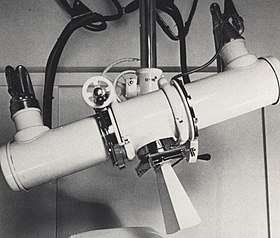Orthovoltage X-rays
Orthovoltage x-rays are produced by x-ray tubes operating at voltages in the 100–500 kV range, and therefore the x-rays have a peak energy in the 100–500 keV range.[1] Orthovoltage X-rays are sometimes termed "deep" x-rays (DXR).[2] They cover the upper limit of energies used for diagnostic radiography, and are used in external beam radiotherapy to treat cancer and tumors. They penetrate tissue to a useful depth of about 4–6 cm.[3] This makes them useful for treating skin, superficial tissues, and ribs, but not for deeper structures such as lungs or pelvic organs.[4]
| Orthovoltage X-rays | |
|---|---|
 A 200 kV orthovoltage x-ray tube used for radiation therapy, 1938. Orthovoltage x-ray machines are similar to diagnostic (radiography) x-ray machines, except that higher voltages are used and the x-ray tube is longer, to prevent the high voltages from arcing across the tube.
ICD10 = | |
| ICD-9 | 92.22 |
| OPS-301 code | 8-521 |
History
The energy and penetrating ability of the x-rays produced by an x-ray tube increases with the voltage on the tube. External beam radiotherapy began around the turn of the 20th century with ordinary diagnostic x-ray tubes, which used voltages below 150 kV.[5] Physicians found that these were adequate for treating superficial tumors, but not tumors inside the body. Since these low energy x-rays were mostly absorbed in the first few centimeters of tissue, to deliver a large enough radiation dose to buried tumors would cause severe skin burns.[6]
Therefore beginning in the 1920s "orthovoltage" 200–500 kV x-ray machines were built.[7] These were found to be able to reach shallow tumors, but to treat tumors deep in the body more voltage was needed. By the 1930s and 1940s megavoltage X-rays produced by huge machines with 3-5 million volts on the tube, began to be employed. With the introduction of linear accelerators in the 1970s, which could produce 4-30 MV beams, orthovoltage x-rays are now considered quite shallow.[8]
See also
- Megavoltage X-rays
References
- Podgorsak, E. B. (2005). "Treatment Machines for External Beam Radiotherapy". Radiation oncology physics: a handbook for teachers and students. Vienna: International Atomic Energy Agency. p. 125. ISBN 978-92-0-107304-4.
- Cerry, Pam; Duxbury, Angela (1998). Practical Radiotherapy: Physics and Equipment. London: Greenwich Medical Media. p. 107. ISBN 9781900151061.
- Hill, Robin; Healy, Brendan; Holloway, Lois; Kuncic, Zdenka; Thwaites, David; Baldock, Clive (21 March 2014). "Advances in kilovoltage x-ray beam dosimetry". Physics in Medicine and Biology. 59 (6): R183–R231. Bibcode:2014PMB....59R.183H. doi:10.1088/0031-9155/59/6/R183. PMID 24584183.
- Hansen, Eric; Roach III, Mack (2007). Handbook of Evidence-based Radiation Oncology. New York: Springer. p. 5. ISBN 9780387306476.
- Zaidi, Zohra; Walton, Shernaz (2013). A Manual of Dermatology. New Delhi: JP Brothers Medical. p. 872. ISBN 9789350904589.
- Khan, Faiz M.; Gibbons, John P. (2014). Khan's The Physics of Radiation Therapy (5th ed.). Philadelphia: Lippincott Williams & Wilkins. p. 41. ISBN 9781469881263.
- Linz, Ute (2011). "From X-Rays to Ion Beams: A Short History of Radiation Therapy" (PDF). Ion Beam Therapy. Biological and Medical Physics, Biomedical Engineering. 320 (1st ed.). Berlin: Springer. p. 6. doi:10.1007/978-3-642-21414-1_1. ISBN 978-3-642-21413-4.
- Cognetta, Armand B.; Mendenhall, William M. (2013). Radiation Therapy for Skin Cancer. New York: Springer. p. 33. ISBN 9781461469865.